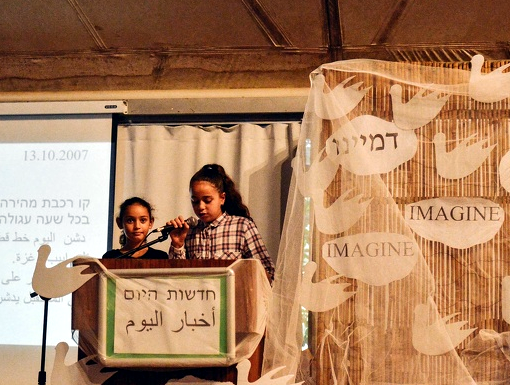Home > Oasis of Peace > Projects & Outreach > Children’s Educational System > Learning about democracy
Learning about democracy
Wednesday 30 November 2016

In October and November, the principal theme for homeroom discussions was democracy. This is the time when the school chooses its student council, but there are also a few markers in Israel’s calendar that help to bring the subject into clear focus. Among these is the memorial to late Israeli P.M. Itzhak Rabin (assassinated November 5, 1995) and the memorial for the Kafr Qasem massacre of October 29, 1956).
Kafr Qasim
Since a decision of Israel’s education board in 2006, the Kafr Qasim massacre has been commemorated in Israeli school’s as an object lesson in looking at the bounds of individual moral responsibility in the face of authority. The 1956 massacre took place in the Arab village of Kafr Qasim, a village bordering the Green Line on the Israeli side. The massacre was carried out when members of the Israel Border Police (Mishmar HaGvul), obeyed their commander’s order and shot 48 men, women and children as wartime curfew violators, when they returned to the village from working in the fields. With this historical reference as background, teachers asked their students questions related to leadership and authority. For example, the students were asked, “Should we always obey our leaders?”
Rabin Day
The students also considered the example of leaders who had themselves died for their beliefs. The anniversary of the Rabin assassination is similarly a date in the Israeli school calendar and is referenced in order to inculcate democratic values. At the WAS-NS school, we sometimes use the opportunity to imagine how a true peace between Jewish Israelis and Palestinians might look.
At an event for the entire school (as well as parents who could arrive) Hezzi Shuster’s fourth grade class were in charge of the morning ceremony. They created an event based on an alternative reality in which Rabin and Arafat had lived to see a permanent peace agreement signed and enacted. The students presented a series of imaginary TV news reports based on this optimistic scenario, and made announcements such as they opening of a railway between Gaza and Tel Aviv, allowing children to travel back and forth between the two. Then, in 2022, the FIFA World Cup would take place in Israel and Palestine with the two states busily preparing ten stadiums for the games.
During the ceremony, the fourth, fifth and sixth graders sang two beautiful songs. One of these was “Imagine” by John Lennon, which the children sang in Hebrew, Arabic and English. The singing was accompanied by a graceful dance by a group of the school girls.
The children were so entranced by the optimistic “news reports” that flowed from the podium, that when it came time to admit that these were only, at best, a dress-rehearsal for a longed for future, some of the younger children actually cried. Nevertheless in Wahat al-Salam - Neve Shalom, we still dare to believe that true peace will some day be possible, Indeed, it may only come if the rising generation can stir their imagination and consider how such a peace might look.
See the photo album from the day
Elections to the Student Council
These hard lessons in democracy preceded the elections for the primary school student council. After a well fought campaign that played out much better than those of the so called “adults” and a scrupulously enacted electronic ballot, the election results arrived on Sunday, November 27. The students from the second grade to the sixth grade participated in the elections. There were one hundred and thirty six votes in total. Itai Agmon, a Jewish boy and Caroline Abu-Riash, an Arab girl, were voted in as the joint chairpersons. Andalus Jaber and Itamar Baruch will both serve as co-chairs. One Jewish student and one Arab student work together in each of these positions. The students elected represent their fellow classmates and act as junior leaders, sitting together and sharing their new ideas and exciting plans. They provide suggestions and help to conduct many important activities. For example, they help to plan the “Upside Down Day”, an event where the students act as teachers and the teachers attend primary school classes as pupils.






